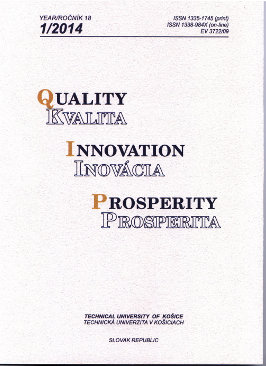Development of an Index for Evaluating National Quality Competitiveness based on WEF and IMD Compiled Indices
Abstract
This study was conducted to develop a national quality competitiveness index (NQCI), necessary to establish national policy standards for quality improvements. For the NQCI, the World Economic Forum (WEF) and the International Institute for Management Development (IMD), internationally recognized indices for national competitiveness, were used. Based on the WEF and IMD, a NQCI composed of four perspectives (capabilities) and 34 indicators was devised. Through the results of implementing the NQCI in 20 selected countries, it shows the comparison and identification of the current standings of countries in national quality competitiveness. From these findings, it is likely that countries’ quality competitiveness weaknesses can be identified and improved through policy suggestions.
Full text article
References
Ahrend, R., 2004. Accounting for Russia's post-crisis growth. OECD Economics Department Working Papers No.404. France: OECD Publishing.
Black, S. A. and Porter, L. J., 1996. Identification of the Critical Factors of TQM*. Decision Sciences, 27(1), p.1-21.
Blackiston, G. H., 1996. Juran Institute: a barometer of trends in quality management. National Productivity Review, 16(1), p.15-23.
Buzzell, R. D. and Gale, B. T., 1987. The PIMS principles: Linking strategy to performance. New York: Free Press.
Cho, D. S. and Moon, H. C., 2005. National competitiveness: Implications for different groups and strategies. International Journal of Global Business and Competitiveness, 1(1), p.1-11.
ERNST&YOUNG, 2010. Tracking global trends. ERNST&YOUNG.
Feigenbaum, A., 1982. Quality and business growth today. Quality Progress, 15(11), p.22-25.
Fingar, C. T., 2009. Global trends 2025: A transformed world. Washington, DC: DIANE Publishing.
Garelli, S., 2006. Competitiveness of nations: the fundamentals. In: IMD World Competitiveness Yearbook. Switzerland: IMD.
Gronroos, C., 1990. Service management and marketing: managing the moments of truth in service competition. Lexington, Mass: Lexington Books.
Juran, J. M., 1988. Juran on planning for quality. New York: Free press.
Lall, S., 2001. Competitiveness indices and developing countries: an economic evaluation of the Global Competitiveness Report. World Development, 29(9), p.1501-1525.
Mehra, S. and Agrawal, S. P., 2003. Total quality as a new global competitive strategy. International Journal of Quality & Reliability Management, 20(9), p.1009-1025.
Mills, T., Dukeov, I. and Fey, C. F., 2007. Russian Competitiveness in the Global Economy. Journal of East West Business, 13(4), p.97.
Pompeo, J., 2007. Living inside China's quality revolution. Quality progress, 40(8), p.30.
Porter, L. J. and Parker, A. J., 1993. Total quality management—the critical success factors. Total quality management, 4(1), pp.13-22.
Porter, M. E., 1998. Competitive advantage: creating and sustaining superior performance: with a new introduction. New York: Free Press.
Reeves, C. A. and Bednar, D. A., 1994. Defining quality: alternatives and implications. The Academy of Management Review, 19(3), pp.419-445.
Saraph, J. V., Benson, P. G. and Schroeder, R. G., 1989. An instrument for measuring the critical factors of quality management. Decision Sciences, 20(4), pp.810-829.
Schwab, K., 2009. The Global Competitiveness Report 2009-2010. Geneva: World Economic Forum.
Schwab, K., 2010. The Global Competitiveness Report 2010-2011. Geneva: World Economic Forum.
Scott, A. and Knott, M., 1974. A cluster analysis method for grouping means in the analysis of variance. Biometrics, 30(3), pp.507-512.
Tyson, L. D. A., 1993. Who's bashing whom?: trade conflict in high-technology industries. Washington, DC: Institute for International Economics.
Ward Jr, J. H., 1963. Hierarchical grouping to optimize an objective function.. Journal of the American statistical association, 58(301), pp.236-244.
Authors
This is an open access journal which means that all content is freely available without charge to the user or his/her institution. Users are allowed to read, download, copy, distribute, print, search, or link to the full texts of the articles in this journal without asking prior permission from the publisher or the author. This is in accordance with the BOAI definition of open access. This journal is licensed under a Creative Commons Attribution 4.0 License - http://creativecommons.org/licenses/by/4.0.
Authors who publish with the Quality Innovation Prosperity agree to the following terms:
- Authors retain copyright and grant the journal right of first publication with the work simultaneously licensed under a Creative Commons Attribution License that allows others to share the work with an acknowledgement of the work's authorship and initial publication in this journal.
- Authors are able to enter into separate, additional contractual arrangements for the non-exclusive distribution of the journal's published version of the work (e.g., post it to an institutional repository or publish it in a book), with an acknowledgement of its initial publication in this journal.
- Authors are permitted and encouraged to post their work online (e.g., in institutional repositories or on their website) prior to and during the submission process, as it can lead to productive exchanges, as well as earlier and greater citation of published work.


